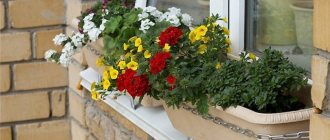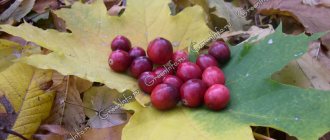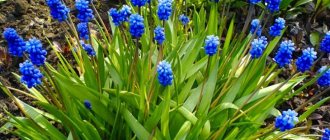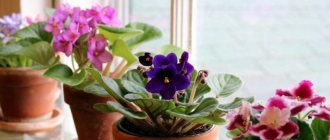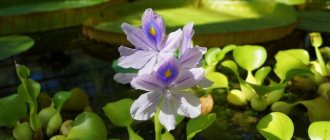Fast-growing indoor plants are always very popular. They are purchased by beginning flower growers, as these species are easy to grow and you can quickly get a beautiful adult specimen. In addition, the price for these varieties is much lower than for plants that need to be painstakingly grown for years.
Among the fast-growing ones there are many decorative foliage and decorative flowering species. Also among them are succulents, indoor fruit crops and even orchids.
Other types of plants with fast growth
In addition to deciduous and flowering ones, there are representatives of the flora that have an unusual appearance and the ability to quickly vegetate. These are drought-resistant succulents of bizarre shapes, dense succulent ferns and epiphytic plants. Caring for them does not require deep knowledge of plant growing; even a novice gardener can easily cope with the task of growing them.
Fast growing spurge succulent
Most succulents grow very slowly. But there are species that can turn into a beautiful adult plant in just 1 year. Euphorbia has many varieties, all of them are unpretentious in care and develop very quickly. It is able to grow in poor soil, easily tolerates long periods of lack of watering, and caring for it will not be a hassle.
Euphorbia myrtifolia
All varieties of milkweed contain milky sap, which gives the flower its name. This juice has not been fully studied, but it is known that it contains the toxic substance euphorbine, which can cause inflammation of the mucous membranes, as well as burns. For this reason, livestock on pastures try to avoid it
When planting or propagating milkweed, you need to be careful and keep it away from children and pets.
Nephrolepis - indoor fern
Nephrolepis rightfully bears the title of the most popular indoor fern. It gained its recognition due to its unpretentiousness and ability to purify the air from dust and pathogens.
Nephrolepis curly
Lush fern bushes are used in hanging and potted arrangements. Nephrolepis does not like direct sunlight, so it is suitable for landscaping rooms whose windows are oriented towards the shady side of the building. The main thing in caring for a plant is proper watering. The higher the room temperature, the more often the earthen ball is moistened. Ferns are propagated by dividing the bush.
Orchids
Orchids are epiphytes; in natural conditions they grow by attaching themselves to other plants without parasitizing them. Epiphytes, capable of existing without soil, grow very slowly, but some species have adapted to growing in soil and can very quickly shoot out stems and grow foliage.
Orchid Rotterdam
These orchids are propagated by cuttings and grown as potted plants. A year after planting, a medium-sized bush is formed from the cuttings. The fast-growing orchid, Ludisia, is most often grown as a houseplant. Another popular decorative species is the vine-like climbing orchid (vanilla). In addition to beautiful flowers, it has unusual variegated leaves, which are used for room decoration.
Which flowers sprout quickly when sown as seedlings and bloom in summer
Most exotic plants in Russia will still have to be grown through seedlings. But here, too, you can select flowers with a quick growing season in order to decorate your site as early as possible.
Zinnia
Zinnia is famous for its spherical inflorescences.
Although the plant can bloom in different shades, pink zinnia is the most loved by gardeners.
The seeds germinate within a week.
Flowering occurs from mid-summer to early autumn.
It is customary to sow seedlings in mid-spring.
Ageratum
This plant blooms all summer until October.
Ageratum is valued for its double “fluffy” flowers and their bright purple hue.
There are several varieties of this flower.
Seedlings are sown in the first half of summer.
Ageratum is widely used to decorate flower beds and garden paths.
Ageratum growing from seeds: when to plant seedlings
Salvia
Seeds for seedlings are sown in early April.
Decorative sage has beautiful bright scarlet inflorescences that look like brushes.
Flowering is bright and long lasting.
There are several groups of varieties (low-growing, medium-growing, tall-growing) that can be combined with other flowers to create flower arrangements.
Snapdragon
This plant has inflorescences that look like small lion's mouths.
Differs in various colors of inflorescences.
It reproduces well by self-sowing, so it can also be grown as a perennial plant.
When grown by seedlings, planting is carried out in early March.
Fast-growing indoor plants will not keep you waiting
A pot for a composition of indoor plants.
how to make a beautiful composition of indoor flowers in one pot. They amaze with the variety of not only flowers, but also with the unusual shape of the leaves. Fast-growing indoor plants will appeal to impatient gardeners. Amazing landscaping occurs in a matter of months. By choosing such crops, the housewife saves her money, because adult specimens have exorbitant prices.
Fast-Growing Houseplants Gain Confidence
Creating an original phytodesign in a new home is the main driving force in acquiring such varieties. Moreover, they attract many gardeners with their unpretentiousness. Crops are able to adapt without problems to unfavorable conditions, such as fluctuations:
- temperature;
- lighting;
- humidity.
They recover well from damage. At the same time, varieties never go out of fashion. The dominant ones among them are decorative deciduous ones, although there are also flowering exhibits. Of course, you shouldn’t expect fast-growing indoor plants to be fashionable and popular.
Variegated dieffenbachia and needle asparagus bushes also luxuriously complement the interior.
Exotic vines
The acquaintance will begin with scindapsus. It belongs to the most variegated varieties. The length of its shoots is 50-200 cm. Bright patterns on the heart-shaped leaves decorate walls, flowerpots and other interior components. Annual growth is 1 meter.
Passionflower is a powerful vine with a hardy character. Dense, wide leaves have a glossy surface. Large flowers (10 cm) amaze with their color palette:
- rich blue;
- neon purple;
- snow-white;
- amazingly blue.
They have an unusual structure inside. An unusual design rises above a base of 10 petals and a fleecy layer. This look is created by a 3D format flower.
Passionflower needs constant garter. Especially when it is in a stage of active growth.
Ceropegia amazes with its delicate patterns on dense foliage. It belongs to the succulent family. Its characteristic feature is bare stems, on which small greenery is thinning. Its blooms also have an unusual appearance. They imitate candelabra lamps, which are painted with small ripples.
It turns out they are high altitude
The leaves of white-veined milkweed resemble chestnut leaves, but only with evenly drawn contours. The crown gradually rises, thanks to the uniform fall of the lower leaf plates. From the outside, the decorative tree looks like a palm tree or cactus. Among other things, the plant scatters seeds into neighboring flowerpots, thereby stimulating its offspring.
Some varieties of begonia reach up to 1.5 m. Wide carved leaves 15 cm in diameter adorn the reddish petioles. The spectacular patterns on them stand out thanks to the shaggy spines. The most exotic cultures can envy its decorative qualities.
There are two fast-growing varieties:
- white-spotted or white-spotted;
- hogweed.
The shoots of these flowers are succulent and strongly climbing. In general, begonias give the impression of pompous and pompous exhibits. It's not difficult to take care of them
It is only important to provide them with a humid environment, as well as diffused lighting.
The list of fast-growing indoor plants can be supplemented with coleus, hibiscus, tradiscantia, nephrolepsis and clerodedrum. Without their help, many designers simply would not have been able to complete their task.
Radish – 21 days
Radishes need no introduction. It is difficult to find a garden where these delicious, juicy root vegetables would not ripen in late spring and early summer. Moreover, both the “roots” and “tops” of radishes are edible. The tops of the plant can be used to prepare salads and green cabbage soup.
21 days after germination, the radishes will be ready to eat.
Radish
Sowing principle
Radishes are sown in open ground from the second half of April, in greenhouses - from the end of March. At the same time, even in open ground, it is advisable to cover the bed with radishes with film until the threat of frost passes. Of course, the seedlings need to be ventilated.
Before sowing, the seeds are germinated in a damp cloth on a radiator. After this, they are embedded in damp soil, deepening it by 2-2.5 cm and maintaining a distance of 5 cm.
Coleus
10 indoor plants from ikea
Known to almost every florist and gardener under the name nettle, the bright plant today is rapidly regaining its former popularity. Literally from a miniature sprout a bush of amazing size can be formed in a matter of months. But growth rate is not the only advantage of coleus, although it would be more correct to call them plectranthus according to the latest botanical classifications.
Coleus
On sale today you can hardly find classic coleus from grandma’s window sills: old varieties have completely replaced new hybrids, the luxurious foliage patterns of which will outshine even begonias. The real boom in coleus varieties is the result of their widespread use in garden culture and in modern landscape design, the echoes of which also influenced the status of their indoor counterpart.
Externally, coleus plants most closely resemble nettles. Reaching a height of 10 cm in bushy forms to more than a meter in species with long shoots, all coleus still boast tetrahedral stems and heart-shaped leaves, along the edges of which there are very beautiful denticles. The surface of coleus leaves is velvety, very pleasant to the touch, the veins only emphasize the play of textures. And we can literally talk endlessly about color variations.
Green, red, yellow, white, orange, pink, purple, almost black colors are mixed in incredible combinations, creating bright patterns and ornaments that seem to be invented by the artist. Moreover, the color on each coleus leaf is unique and at least slightly different from its neighbor. Coleus inflorescences, although they resemble clasps with their spicate structure, have a negative effect on shoots and leaves, so it is better to avoid them.
Possibility of using coleus:
- as a color accent;
- to create a bright and cheerful background for relaxation;
- as an optimist plant and companion for crops with classic greens;
- in groups and collections with flowering indoor crops;
- for seasonal decor;
- in large groups with other coleus plants as space dividers.
Required conditions for coleus: full sun to shade.
Features of caring for coleus: pruning, shaping, abundant watering and standard feeding.
Coleus. Malin Fagrell
Pea sprouts – 20 days
Of course, it is impossible to harvest peas 3 weeks after emergence. But we’ll tell you a little secret: it’s not necessary to wait for the ovaries to form (and even more so for the fruits to ripen), because pea sprouts are extremely tasty and healthy. Why not add them to fresh salads, sandwiches, stews and other dishes?
Pea sprouts
Sowing principle
Peas are a cold-resistant crop, so they can be sown in open ground as early as the third decade of April, provided that the snow has completely melted and the soil has dried out. If you are going to grow pea sprouts on the balcony, you can safely sow even earlier.
Before sowing, pea seeds must be prepared. To do this, wrap them in damp toilet paper, wrap them in cling film and leave them on the radiator for a day.
After this, sow the peas to a depth of 3-5 cm, based on the norm of 80-130 seeds per 1 sq.m.
- Microgreens on the windowsill - a new trend in home gardening
What are microgreens and how to grow them?
20 days after germination, the sprouts can be cut and eaten.
Tradescantia
Pests of indoor plants
Everyone's favorite perennial plant, which is found in almost every apartment. Tradescantia has about 75 species, differing in size, color and leaf pubescence. The plant perfectly purifies the air and absorbs harmful substances, which is why it is popular.
Owners of indoor flowers note that Tradescantia produces new shoots very quickly. Especially if its branches touch other pots or plants, the flower tries to expand its boundaries and quickly captures new territory. It may even move into a neighboring flowerpot. Therefore, it is better not to place it close to other colors.
Catnip
Wild catnip has always been considered a magical plant.
Thanks to its healing properties, it was in the “first aid kit” of every herbalist. Now many summer residents choose fragrant perennials exclusively for garden decoration. Low-growing varieties are suitable for framing garden paths; tall varieties can become the center of a mixborder or decorate an artificial pond. The more shaded the place chosen for planting, the higher the shoot will stretch. In open, sunny spaces, flowers quickly grow in width and rarely reach a height of more than 50 cm.
Pepper nightshade or Cuban cherry (Malpighia)
A spectacular plant, often simultaneously covered with white flowers and bright fruits of varying degrees of ripeness - from green to orange and red. Propagated by cuttings and seeds. Used for decorative purposes, the fruits are poisonous; in folk medicine, infusions are prepared from them for gargling for sore throats and the oral cavity for inflammatory tissue lesions.
Caring for Cuban cherries involves regular watering and fertilizing, periodic pruning of the bush and replanting in fresh soil. Lighting should be diffused; in summer the optimal temperature is between 18–25°C; in winter it is recommended to reduce it to 15°C.
Installation of supports
Climbing annual flowers climb upward in two ways:
- They are attached to the support with tendrils (sweet peas, decorative beans).
- They twine shoots around a support (morning glory).
In the first method, the optimal solution for support is wire or soft mesh. In the second method, there is a thin, rigid stand, and the shoots are tied to it.
When installing supports, it is necessary to take into account that some types of annual vines can stretch to a height of 3 meters or more. Arches, gazebos, metal trellises, pergolas, and all kinds of buildings, including fences and terraces, are widely used as supports.
Gesneriaceae
This is a whole group of magnificent flowering plants that are not difficult to grow from seeds. These include the familiar kohleria, gloxinia, streptocarpus, and saintpaulia. There are no special rules for growing new specimens; these flowers are not too demanding in care. The main thing for them is the presence of light, stable temperature and moderate watering.
Gloxinia. Brian Valentine
All Gesneriaceae are easily propagated by leaf cuttings, but it is seed propagation that makes it possible to obtain new varieties. In stores and from collectors you can find varieties with double flowers of all kinds of colors.
Delphinium
Due to its decorative qualities, delphinium is extremely popular among gardeners. Reaching two meters, perennials and annuals strewn with lush double inflorescences can be propagated in several ways:
- Seeds. Pre-planting material will have to be stratified.
- Dividing the bush. Suitable for plants over 3 years old.
- Propagation by cuttings. An overgrown delphinium requires a lot of attention from the gardener: it is necessary to tie up the stems, thin out the bushes, and fertilize.
How to choose?
Large plants should be selected very carefully. The conditions of the apartment should allow you to place the flower in a relatively comfortable environment. Often giant exotics require special care or a special climate in the apartment.
It is best to give preference to the least fastidious specimens
Their appearance also attracts attention and decorates the apartment, but the gardener does not risk losing a new plant due to a lack of knowledge and skills
When choosing a giant you need to pay attention:
- on the speed of growth (the dimensions of the apartment sometimes do not allow keeping adult specimens);
- features of maintenance (to what extent the apartment allows them to be provided);
- appearance.
Plumeria
Another representative of tropical vegetation is plumeria. This amazingly beautiful flowering plant is also called frangipani. The flowers, opening, exude an incomparable, exotic aroma. In addition to the classic white, the flower has pink, crimson, yellow and even orange colors in its “reserve”.
Plumeria. Jacob Tidwell
Getting it from a seed is not at all difficult, and an adult plant will not cause any trouble. Frangipane grows very quickly, reaches impressive sizes (up to 2 meters), requires frequent replanting and a considerable area indoors, abundant watering and a sunny location.
Answers to frequently asked questions
What flowers should I plant in my dacha if I rarely go there?
Marigolds and marigolds are best suited in this case. These are very unpretentious and drought-resistant flowers. They will have enough precipitation.
What flowers are the most beautiful?
This is purely a matter of taste. Some people like marigolds, while others prefer snapdragons.
What flowers should I sow?
If you are a beginner gardener, then do not immediately start planting exotic plants. Start with nasturtium, calendula, marigold, cornflower, etc., which are familiar to our climate. They bloom quickly and withstand bad weather.
Deciduous crops
In a short time, you can green up a recreation area on your personal plot by planting fast-growing deciduous trees. Now these are the main landscapers of the whole country. The leaves and flowers of some of them secrete phytoncides that disinfect the air. In just 2–3 years they will provide dense greenery and abundant shade. Most Popular:
| Name | Annual growth, m | Maximum height, m | Barrel diameter, cm | Average life expectancy, years |
| Birch | up to 2 | up to 45 | 50–70 | 300 |
| White acacia | up to 1.5 | until 25–30 | 30–40 | up to 50 |
| Willow | 0,5-1,0 | 15–40 | up to 100 | 20–150 |
| Maple | up to 2 | 30 | up to 100 | 200 |
| Poplar | more than 2 | 40 | up to 300 | up to 400 |
Deciduous crops adapt well to changing weather conditions. Some beneficial substances of these trees are used in medicine. It is better to plant seedlings in the fall. At the initial stage of growth, they need frequent and abundant watering. After successful rooting, they produce strong shoots next year.
The idea of “your own forest” with deciduous trees several tens of meters long is unlikely to occur to a person with a traditional six hundred square meters.
Top best colors for an apartment
To make it easier for you to choose flowers, we have selected the most common and best flowers for the home that can be bought in any region. But do not forget that each species requires individual care and conditions. Before purchasing, be sure to check with your florist for detailed care instructions.
Scheffler
Let's start the list with a type that should be in every home of someone who smokes tobacco. He will most likely protect not the smoker, but his relatives. This plant absorbs tar, nicotine and other unpleasant substances and destroys them. This type of sprout belongs to the Araliaceae family. If you have a lot of bright natural light in your apartment, the plant will acquire a bright yellow color.
Aloe
Aloe is the most common sprout and has gained particular popularity. This species completely cleanses the climate of formaldehyde and the unpleasant smell of “new things”. Aloe is used to treat colds: acute respiratory viral infections, acute respiratory infections and rhinitis. The most important thing is that the phytoncides contained help improve brain function and relieve fatigue. This species is considered one of the best house plants that remove formaldehyde.
Dracaena
Dracaena, or as it is popularly called, air orderly. The plant effectively copes with the removal of benzene and trichlorethylene, which enters our apartments through exhaust on the roads.
Dieffenbachia
This type will be useful for people who suffer from pulmonary diseases. Dieffenbachia completely fights staphylococcus bacteria, destroys xylene and toluene.
Interesting to know: Dieffenbachia traps and removes harmful chemicals from paint materials that may be found in floor coverings and walls.
Begonia
Begonia is an assistant for housewives, as it attracts dust and humidifies the air. To start the cleaning mechanism of this plant, spray a little water on the begonia and it will instantly begin to absorb dust into itself. What other advantages are there in this form:
- destroys fungus and microbes;
- absorbs radiation from devices;
- has beautiful looking flowers.
Lemon Tree
A citrus tree is the perfect decor for your home, but it has other benefits besides its appearance:
- purifies the air;
- fights germs and bacteria;
- Essential oils of this tree calm the nervous system.
But it is worth noting that this tree requires special care.
indoor cypress
Cypress purifies the air and makes the climate in the apartment fresh and clean. The main advantage of this sprout is that it absorbs negative ions and gives us positive ones. Owners of cypress trees will immediately feel an improvement in the air in the room.
Gerbera
Gerberas are mainly used as decoration and used to decorate their window sills. But many do not know that this species improves our sleep and removes benzene.
bamboo palm
One of the best indoor plants is the chamedorea or bamboo palm, which can grow up to 2 meters, but there is also a dwarf variety. Hamedorrhea works as a humidifier that can deal with formaldehyde fumes.
Mother-in-law's tongue
If you have children, Sansevieria is your plant. Mother-in-law's tongue absorbs many harmful chemicals such as nitric oxide, formaldehyde and harmful emissions from plastic. The most interesting thing is that this plant can remove carbon dioxide within one night.
indoor geranium
The perfect plant to brighten up your space while fighting germs and other harmful bacteria.
Important: geranium releases beneficial essential oils that improve our sleep and restore the nervous system. But this sprout causes allergies in many people.
If you have allergies in your home, refrain from buying geraniums.
Spathiphyllum
Another cleaning assistant, it is even called a “bedspread”. In addition to its beauty, it has a number of advantages: it destroys mold and cleans the air from bacteria, carbon dioxide, acetone and benzene.
Violet
A flower of peace that will relieve depression and fatigue. Violet will lift your spirits and protect against illnesses. What other advantages are there:
- cleans and moisturizes the room;
- removes carbon monoxide from the air;
- stimulates brain function.
This list contains the best flowers for the home, which will not only decorate your interior, but will also do a great job of improving your home climate. Each flower is endowed with individual beauty that will highlight your apartment style.
Ivy (Hedera)
It is an evergreen vine with decorative leaves of green or variegated color. Ivy is characterized by rapid growth; in a year the length of its shoots can increase by 1 m. It is also famous for its longevity - in its homeland, in a number of European countries, there are specimens aged 500 years or more. For normal development, ivy requires a room temperature of 18–20°C. At higher values, the plant feels comfortable thanks to periodic spraying or humidifying the air in some other way.
It is advisable to provide variegated species with bright, but diffused lighting, otherwise their color will become uniformly green. Ivy with regular leaf colors can grow on a northern windowsill or at some distance from a southern or eastern window. Water the plant as the soil dries out: in warm weather - 1 or 2 times a week; when kept in a cool room in winter, it is enough to moisten the soil once every 2 weeks. The nutrient substrate should be light, loose, and contain humus and sand.
Question to an expert What types of unpretentious plants prefer abundant watering and are not afraid of constant soil moisture? They prefer to grow in water and do not suffer from excessive moisture: cyperus, bamboo, bacopa carolina, pontederia, eichornia, anubias, calamus, graceful isolepis. They are ideal for beginners, as there is no need to worry about stagnant moisture, which is detrimental to ordinary plants. Also, species growing in water can increase the air humidity in the room and it is useful to place containers with them next to other indoor flowers.
Climbing perennial fast-growing plants
Fast-growing plants for the garden and garden come in different heights, which must be taken into account when choosing greenery, as well as different degrees of growth speed. Installing strong supports is necessary so that the sprouts cling to the tendrils or wrap around them. Growing is not difficult. Special efforts may be required only at the stage of planting and rooting, when the sprout needs regular watering, tying up and shaping directions for growth. Almost all perennial ornamental vines need to be covered for the winter. Let's look at the most popular examples.
Wild grapes
They are planted in both the northern and southern parts of the site. Features in the location affect the color of the leaf plate. It can be rich green, yellow, purple-orange. Grapes are picky about soil composition. It must be fertile.
Typically, woodiness of the lower part of the column occurs within 1-2 seasons. Until this happens, you should take care of the correct slope or tie it up for even growth. From several sprouts you can create original braids or patterns, which will undoubtedly add extravagance to the composition.
Maiden grapes are especially popular, as they are not whimsical, are distinguished by their original leaf color depending on the season, and even bloom beautifully. This vine is green in spring and purple in autumn. Fruits in the form of black berries give a special effect. Grows up to 20 m, clinging with tendrils.
More about wild grapes - in the article “Girl grapes“.
Spectacular ivy
Clinging to any unevenness, it perfectly camouflages fences and walls. It is shade-loving, which is uncharacteristic of most green spaces. In our region, it is loved for its resistance to low temperatures. But it is demanding in terms of care in terms of watering.
Moisture is necessary for the root system to strengthen. This tree-like vine has carved leaves. It grows very quickly and literally in one season one sprout can cover an area up to 2 m high and one and a half meters wide. These are the best perennial climbing fast-growing plants for a fence that will suit any garden.
You can learn more about ivy in our article.
Hop
Densely growing greenery creates corners of coolness in the area and looks very attractive.
In the process of rooting and further development, he is demanding of such nuances as:
- regularity of watering;
- feeding;
- prevention and control of aphids.
Winds clockwise. It blooms in July and lasts until the end of summer. There are two types of hops. One of them, Japanese, is an annual, and the second is a perennial and is called climbing or ordinary. A temperate climate suits it. If it is not possible to frequently water the rhizome, then you can plant grass or shrubs nearby that create shade.
Large-leaved tree plier
Perennial, winter-hardy, climbing, fast-growing plants are used for landscaping areas where the soil is not always full of nutrients and sunlight is either partial or, conversely, constant.
In such conditions, a climbing vine called wood pliers can survive. It is suitable for any climatic conditions and does not require maintenance. But there is also a negative aspect: trees cannot grow next to it due to the power of the root system.


